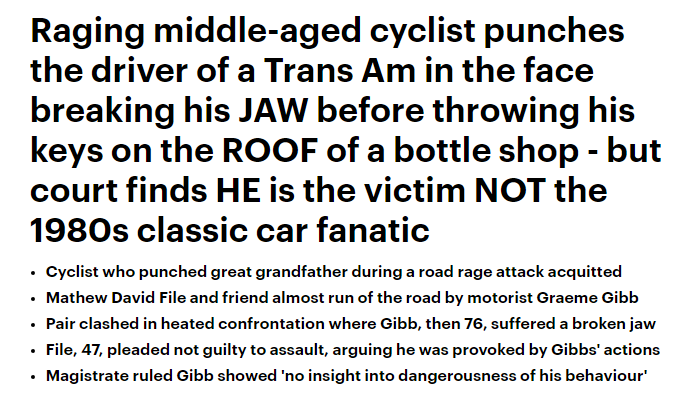A few weeks ago I read this article about a conflict between a driver and a cyclist, and since then, something’s been creeping around in the periphery of my thoughts.
The Article
In August 2020 in Queensland, Australia, a driver did a “close pass” on a cyclist, coming within 20cm (about 8”). A few minutes later, the driver pulled over and confronted the cyclist. Words were exchanged, the conflict coming to a head when the cyclist punched the driver and broke his jaw. The cyclist was charged with assault. A judge subsequently cleared the cyclist of the assault charge.
The Ruling
The judge, when referring to the driver’s purposeful close pass, ruled she was “satisfied that that unlawful act frightened, alarmed and unnerved” the cyclist. Furthermore, the judge stated:
“I find that this conduct deprived the defendant of the power of self-control.”
“I accept that he was significantly shaken as a result when minutes later he has sought to confront the driver,” whom she said had “demonstrated no insight at all into the dangerousness of his behaviour.”
My Thoughts
I’ve spent a significant portion of my adult life pondering the topic of conflicts between drivers and cyclists. I’ve blogged about it, and even wrote a book about it. So, after reading this article, it took me a few weeks to get my thoughts in order. Here it is.
In the Queensland conflict, what that court effectively said was that the driver provoked the cyclist. The driver used the size and weight of his vehicle to intimidate the cyclist. It’s what we cyclists call the “punish pass”—a motor vehicle driver intentionally passing close enough to intimidate or create fear. Some drivers do this to show their displeasure with a cyclist’s behaviour, their road position, or, believe it or not, what they’re wearing. Sometimes just the mere presence of a cyclist is enough to trigger a driver to initiate a punish pass. The cyclist in this article felt sufficiently shaken and frightened that his response, when confronted by the driver minutes later, was considered not unreasonable by the court. The cyclist felt threatened and responded the way many people would—he struck back.
I’ve spent over 20 years commuting by bike in Metro Vancouver, as well as countless hours riding for pleasure or training for bike races and triathlons. I’ve experienced my share of punish passes and other run-ins with bullying drivers. I’ve also had, on rare occasions, the opportunity to immediately confront those bullies, such as at the next red light or stop sign. Here’s what I said:
“You’re pretty tough when you’re in your car. Why don’t you step outside and let’s see how tough you really are?”
In all my years of cycling, no one has taken me up on the offer. Mind you, I’m 6’4” tall, weigh just over 200 pounds, and more than capable of handling myself should someone choose to go “mano y mano” with me. But that sort-of proves my point—when behind the wheel, many people will behave towards others in a manner they’d never consider doing if they were, say, walking down a busy street. Imagine what would happen if a small person who was walking down the sidewalk purposely pushed a larger person out of the way? That probably wouldn’t end well for the aggressor. But put that same small person behind the wheel, they’re quite willingly bully a pedestrian or cyclist. Why? Because they can.
Imagine you’re walking down a busy street, minding your own business, and some big guy just pushes past you and knocks you down. In many jurisdictions, that’s assault. A criminal act. Yet it’s rare that drivers are called out for similar behaviour.
Here’s the point I want to get across to drivers: if you use your vehicle to intimidate or threaten a vulnerable road user such as a cyclist, don’t be surprised if they interpret your actions as a threat to their safety, their very life. Whether you acknowledge it or not, you just provoked them. You challenged them to a fight. An incredibly unfair fight, but a fight nonetheless. Is it hard to believe that the cyclist might get angry? Should you be surprised if that cyclist catches up to you at the next red light and starts banging on your hood or window? Or invites you to get out of your car? From their perspective, you just tried to injure or kill them. On purpose. Small wonder they’re upset. Imagine if the situation were reversed, and you were the cyclist? How would you feel?
Sidebar on Reporting Bias
What’s also interesting about this story is how differently it was reported on in online media. Here are two completely different headlines about the same story:
The one on the left is courtesy of the UK’s Daily Mail tabloid. The cyclist is referred to as “raging,” and “middle-aged,” while the driver is a “1980s classic car fanatic,” a “great grandfather,” and 76 years old. The one on the right is from a cycling website (road.cc). Isn’t the difference remarkable? Which do you think is more balanced reporting?




 RSS Feed
RSS Feed